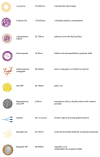Targeted Nanocarrier Delivery of RNA Therapeutics to Control HIV Infection
- PMID: 35890248
- PMCID: PMC9324444
- DOI: 10.3390/pharmaceutics14071352
Targeted Nanocarrier Delivery of RNA Therapeutics to Control HIV Infection
Abstract
Our understanding of HIV infection has greatly advanced since the discovery of the virus in 1983. Treatment options have improved the quality of life of people living with HIV/AIDS, turning it from a fatal disease into a chronic, manageable infection. Despite all this progress, a cure remains elusive. A major barrier to attaining an HIV cure is the presence of the latent viral reservoir, which is established early in infection and persists for the lifetime of the host, even during prolonged anti-viral therapy. Different cure strategies are currently being explored to eliminate or suppress this reservoir. Several studies have shown that a functional cure may be achieved by preventing infection and also inhibiting reactivation of the virus from the latent reservoir. Here, we briefly describe the main HIV cure strategies, focussing on the use of RNA therapeutics, including small interfering RNA (siRNA) to maintain HIV permanently in a state of super latency, and CRISPR gRNA to excise the latent reservoir. A challenge with progressing RNA therapeutics to the clinic is achieving effective delivery into the host cell. This review covers recent nanotechnological strategies for siRNA delivery using liposomes, N-acetylgalactosamine conjugation, inorganic nanoparticles and polymer-based nanocapsules. We further discuss the opportunities and challenges of those strategies for HIV treatment.
Keywords: HIV; RNA therapeutics; delivery; latent reservoir; nanocarrier; siRNA.
Conflict of interest statement
The authors declare no conflict of interest.
Figures






Similar articles
-
A Review of Current Strategies Towards the Elimination of Latent HIV-1 and Subsequent HIV-1 Cure.Curr HIV Res. 2021;19(1):14-26. doi: 10.2174/1570162X18999200819172009. Curr HIV Res. 2021. PMID: 32819259 Free PMC article.
-
Controlling HIV-1: Non-Coding RNA Gene Therapy Approaches to a Functional Cure.Front Immunol. 2015 Sep 16;6:474. doi: 10.3389/fimmu.2015.00474. eCollection 2015. Front Immunol. 2015. PMID: 26441979 Free PMC article. Review.
-
From reactivation of latent HIV-1 to elimination of the latent reservoir: the presence of multiple barriers to viral eradication.Bioessays. 2013 Jun;35(6):544-52. doi: 10.1002/bies.201200170. Epub 2013 Apr 24. Bioessays. 2013. PMID: 23613347 Free PMC article. Review.
-
The Contributions of Clinical Pharmacology to HIV Cure Research.Clin Pharmacol Ther. 2021 Aug;110(2):334-345. doi: 10.1002/cpt.2237. Epub 2021 Apr 18. Clin Pharmacol Ther. 2021. PMID: 33763860 Free PMC article. Review.
-
Targeted delivery methods for RNA interference are necessary to obtain a potential functional cure for HIV/AIDS.Adv Drug Deliv Rev. 2023 Aug;199:114970. doi: 10.1016/j.addr.2023.114970. Epub 2023 Jun 28. Adv Drug Deliv Rev. 2023. PMID: 37385543 Review.
Cited by
-
Advanced Therapies for Human Immunodeficiency Virus.Med Sci (Basel). 2024 Jul 18;12(3):33. doi: 10.3390/medsci12030033. Med Sci (Basel). 2024. PMID: 39051379 Free PMC article. Review.
References
-
- Schlimgen R., Howard J., Wooley D., Thompson M., Baden L.R., Yang O.O., Christiani D.C., Mostoslavsky G., Diamond D.V., Duane E.G., et al. Risks Associated with Lentiviral Vector Exposures and Prevention Strategies. J. Occup. Environ. Med. 2016;58:1159–1166. doi: 10.1097/JOM.0000000000000879. - DOI - PMC - PubMed
-
- Kaur I.P., Sharma G., Singh M., Sandhu S.K., Deol P.K., Yadav M., Yakhmi J.V. Chapter 13—Nanobiomaterials as gene-delivery vehicles. In: Grumezescu A.M., editor. Nanobiomaterials in Drug Delivery. William Andrew Publishing; Norwich, NY, USA: 2016. pp. 447–486. - DOI
Publication types
Grants and funding
LinkOut - more resources
Full Text Sources

